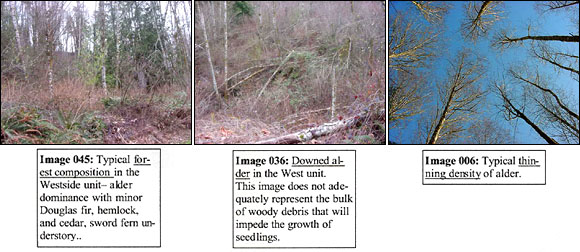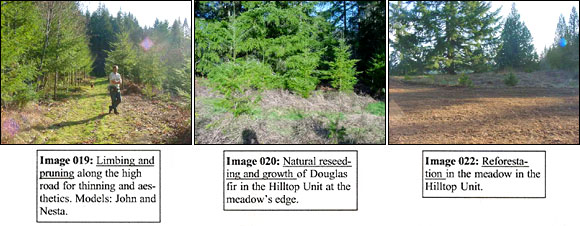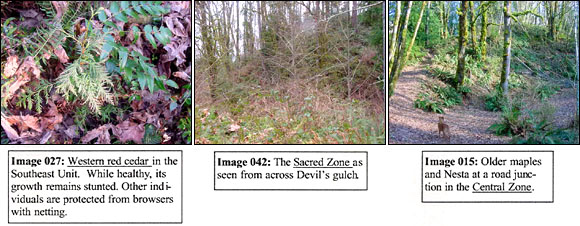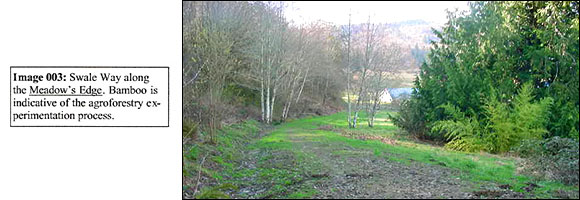















1. Cover Page
2. Table of Contents
3. Objectives
4. Property
5. Resources
5.1 Forest Health
5.2 Soils
5.3 Water Resource
5.4 Timber
5.5 Wildlife
5.6 Forest Grazing
5.7 Aesthetics and
Recreation
5.8 Forest Products
6. 10-Year Plan
|
|
|
Forest Stewardship Plan
5.4 Timber (Forest Units Map)
The landowner's intention is to increase the overall timber quality and value on the property, regardless of whether or not it is harvested in the immediate future. A long rotation harvest is the long-term objective. The little harvesting occurring at this time is being mainly being executed for purposes of stand enchancement of after a tree or stand has exhibited structural or ecological weakness. Chemically fertilizing is not consistent with the overall landowner objectives.
Stand 1- Westside Unit (Image 045)
This stand is uneven-aged and under-stocked, consisting of a mix of alder, Western red cedar, Western hemlock (Tsuga heterophylla), and Douglas fir. A considerable amount of all overstory trees are topped. Main overstory species are alder, maple (Acer macrophyla), Douglas fir, Western red cedar, and hemlock. There is no true dominant species at this successional stage, however some large diameter cedar and hemlock were spared in early clearcuts because of their low market value. This unintentionally contributed to the unitís structural integrity. Understory components consist of salal (Gaultheria shallon), bitter cherry (Prunus emarginata), Indian plum, sword fern (Polystichum californicum), deer fern (Blechnum spicant), maidenhair fern (Adiantum pedatum), Oregon grape (Mahonia nervosa), elderberry (Sambucus racemosa), wood rose (Rosa gymnocarpa), trailing blackberry (Rubus ursinus), thimbleberry (Rubus parviflorus), salmonberry (Rubus spectabilis), and creeping woodsorrel (Oxalis corniculata). The tree diameter distribution is fairly uniform. The topography varies but can be steep in areas. This unit is proximate to the bottomlands and comprises the western section of the steep north-facing band that surrounds the farm on three sides. The soil type is Buckpeat silt loam, 30-65% slope. It is best suited for woodland management and Douglas fir cultivation.
Management Options and Recommendations
The management options in this unit are prolific because of the ice storm disturbance. The forest floor has been colonized by understory species, leaving a condusive medium for the replanting of overstory species characteristic late sucessional forests. However since the forest floor is currently covered with alder debris, replanting at this time poses challenges to both the planter and the seedlings (Appendix H, 036). As the alder decomposes and the forest floor becomes increasingly accessible I recommend later successional species like Douglas fir and Western red cedar be planted. I recommend that management activities currently practiced by the landowner (including felling dangerous trees, clearing roads, felling species being out-competed) (Image 006) be continued.

Stand 2- Southwest Unit
This stand is uneven aged and under-stocked, but less so than the Westside unit. Main overstory species are Douglas fir, Grand fir (Abies grandis), alder, maple, Western red cedar, and hemlock. . Understory components consist of bitter cherry, Indian plum, Pacific dogwood (Cornus nuttallii), sword fern, Oregon grape, elderberry, rose, trailing blackberry, salmonberry, and creeping woodsorrel. The tree diameter distribution is fairly uniform. The topography of this unit is a gradual slope leading up the ridgeline, the dominant feature of the forest. It is north facing but at the ridgeline begins to have a south facing inclination. The soil type is Buckpeat silt loam, 30-65% slope. It is best suited for woodland management and Douglas fir growth.
Management Options and Recommendations
The same management practices recommended for Stand 1 should be considered here. I recommend maintaining the stability of the headwaters of the West ravine through strategic replanting. Limbing for aesthetics and timber should be continued (Image 019).
Stand 3- Hilltop
This stand consists of an open meadow on the upper ridge harboring scattered conifer species, an adjacent Douglas fir plantation, and a conifer dominated stand to the south of the ridgeline. This unit is managed for aesthetics, late successional forest composition, and aesthetics. The topography is mainly flat. The soil type is Centralia loam, 8-30 % slope. The soil type is primarily for use as woodlot.
Management Options and Recommendations
There is little management for timber in this area as is the preference of the landowner. The later-successional forest should be monitored for fire danger and treated if it becomes a problem. Pond creation for woodland wildlife and aesthetics should be considored in the wet marshy area adjacent to the Douglas fir grove. Reforestation in the meadow should be continued (Images 020, 022).

Stand 4- Southeast Unit
The southeast unit is an uneven aged mixed conifer/hardwood stand with a southeastern facing inclination. Main overstory species are alder, maple, Douglas fir, Western red cedar, Grand fir (Abies grandis), and hemlock. There is no single dominant species. Understory components consist of bitter cherry, Indian plum, Pacific dogwood (Cornus nuttallii), Cascara buck-thorn (Frangula purshiana), sword fern, snowberry, Oregon grape, elderberry, rose, trailing blackberry, salmonberry, and creeping woodsorrel. The tree diameter is varied. The topography is gently sloping. The soil type is Centralia loam, 8-30 % slope.
Management Options and Recommendations
Current management practices should be continued. Timber that falls should be culled as economically viable and necessary. The overstory is understocked from a timber standpoint, and the Western red cedar that was underplanted, while protected with netting, does not seem to be responding well (Image 027). I recommend that its growth be monitored and if it remains stunted I recommend the causes are looked into and remedied.
Stand 5- Steep North Face
The steep north face is an uneven-aged mixed conifer/hardwood stand. There is no one dominant species, rather alder, maple, and Douglas fir co-dominate with minor elements of hemlock and Western red cedar. The tree diameter distribution is fairly, but not dramatically, uniform. The topography is steep and north facing, similar to the Westside unit in its proximity to the farm and dramatic slope. The soil type is Buckpeat silt loam, 30-65% slope. It is best suited for woodland management and Douglas fir growth.
Management Options and Recommendations
The area should be minimally managed as is the landownerís objectives. Management, if any, should consist of replanting late-successional species in the understory and culling fallen timber as is economically viable.
Stand 6- Sacred Zone (Image 042)
The sacred zone is a small unit embedded in the southeast unit. It is a mixed species uneven-aged stand. The stand is composed primarily of maple with minor elements of alder and Douglas fir. The understory is sword fern dominated. The terrain is moderately sloped, on the far side of the ridge, and east facing. The soil type is Centralia loam, 8-30 % slope. The soil type is primarily conducive to use as woodlot.
Management Options and Recommendations
No management activities should occur in this area as consistent with the landownerís objectives. If a pest outbreak were to occur I recommend the area be treated and a unit equal in size to the Sacred Zone be left unmanaged in another area of the forest.

Stand 7- Central Zone (Image 015)
The central zone has an ecological composition similar to Unit 5, the Steep North Face. The diameter distribution is fairly uniform. The topography is steep and north facing. The soil type is Buckpeat silt loam, 30-65% slope. It is best suited for woodland management and Douglas fir growth.
Management Options and Recommendations
The landowner desires this unit to acquire late succesional charcteristics and retain its native species composition. This process can be expedited through under planting late successional species and felling trees that are being outcompeted. This should be done at the landownerís discretion.
Stand 8-Meadow Edge (Image 003)
The meadow edge comprises the border between the forest and the farm , hence there is no dominant species or stand type. There are many non-native, demonstration species in this zone, such as Quaking aspen (Populus tremuloides), Mountain ash (Sorbus aucuparia), Red oak (Quercus rubra), and bamboo (various spp). The tree diameter varies. The topography is very gently sloping or flat. The soil type begins the transition from Buckpeat silt loam to Chehalis silt loam. Silt loam is characteristic of agricultural use.

Management Options and Recommendations
Demonstration and experimental processes should be continued, especially considering the compatibility of the soil type to cultivation. Aesthetics should continue to be a management priority considering the high visibility of this unit from the main farm complex. Firewood is harvested and culled from this unit because of its proximity to the farm complex. This does not seem to have significant adverse effects and can be continued.
|




